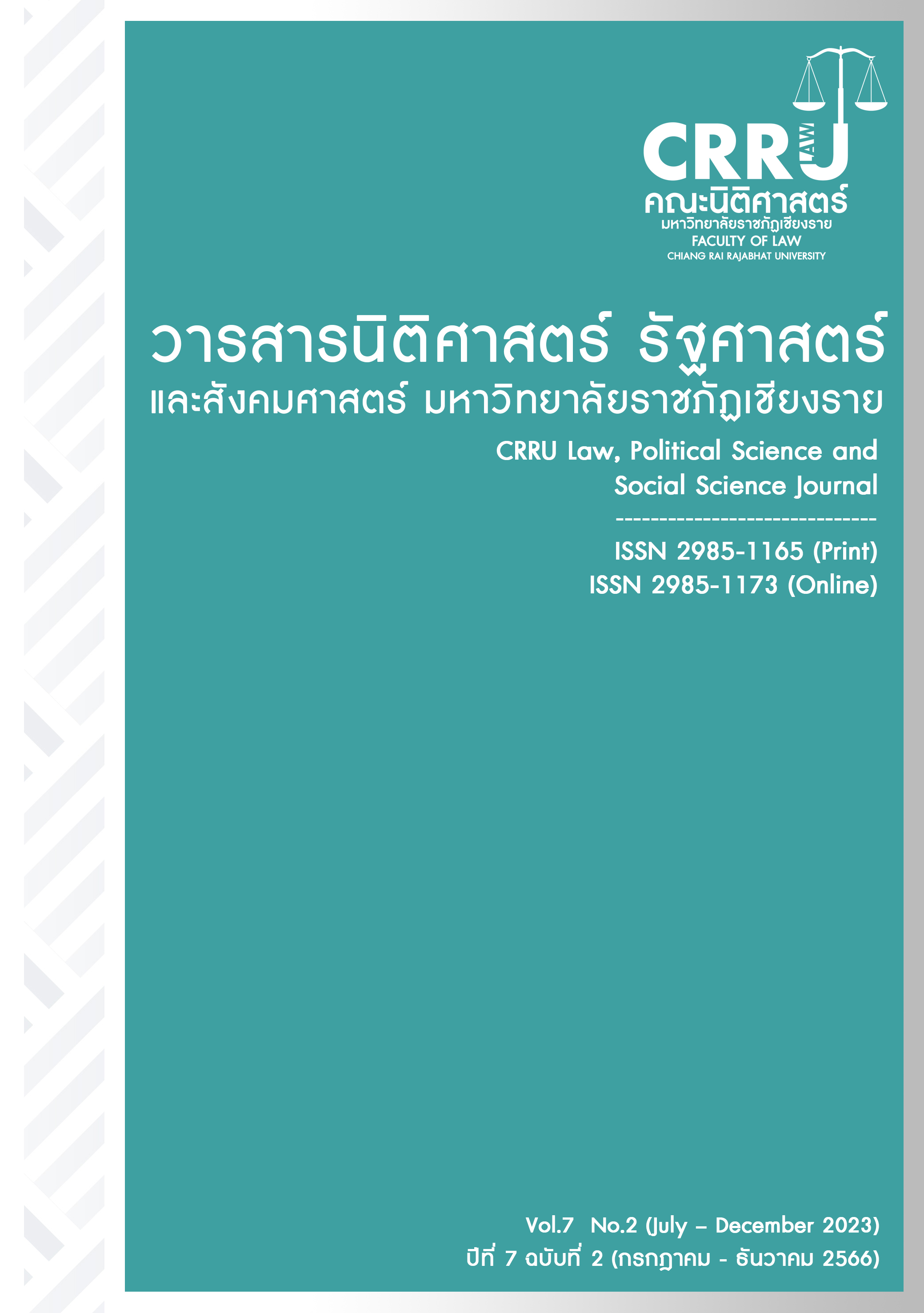The Empowerment Process of the Elderly Group Towards Participatory Products Development and Enhancement: A case study of Rattan Handicrafts Group in Ngew sub-district, Thoeng district, Chiang Rai Province.
Main Article Content
Abstract
The objectives of this research are to (1) study the context and problem situation, (2) study the methods to empowerment, and (3) develop a model to empower the elderly rattan handicrafts group to become entrepreneurs with participation in Ngew sub-district, Thoeng district, Chiang Rai province.
This research is qualitative methods based on participatory action research (PAR). The key informants are a member of the rattan handicraft group, community leaders, and 22 people. The research tools were an in-depth interview, and a focus group discussion and analyzed using social Interaction analysis.
The results showed that the elderly member of the rattan handicraft group in Teng District, Chiang Rai Province, who belong to the weaving handicraft group, faced problems in terms of group management and structure, lack of participation. In addition, they also faced difficulties in developing entrepreneurial skills.
Guidelines for enhancing the empowerment of the elderly member of the rattan handicraft group in Ngew sub-district. By applying the concept of "Empowerment" along with the implementation of the "STRONG Model"
For the development of the empowerment model, the focus should be on involving network partners in the driving area to carry out tangible activities, namely empowerment in terms of knowledge, economics, and administration.
This research suggests that the government agencies and various local organizations in the area should develop strategic plans and operational plans to empower the Enterprise Rattan Handicrafts Community Group in Ngew sub-district as proactive leaders in community development and these plans should be applied to other elderly groups as well.
Article Details
References
กรมอนามัย. “โครงการเฝ้าระวังและพัฒนาสารสนเทศสุขภาพผู้สูงอายุ ปี 2566.” http://doc.anamai. moph. go.th/index. php?r=str-project/view&id=6238. สืบค้นเมื่อ 25 มีนาคม 2566.
กรมกิจการผู้สูงอายุ กระทรวงการพัฒนาสังคมและความมั่นคงของมนุษย์. “แผนปฏิบัติการด้านผู้สูงอายุ ระยะที่ 3 (พ.ศ.2566-2580).” https://www.dop.go.th/th/laws/1/28/843. สืบค้นเมื่อ 25 มีนาคม 2566.
กาญจนา รอดแก้ว. “การพัฒนารูปแบบการเสริมพลังชุมชน การเฝ้าระวังทางสังคมและดูแลช่วยเหลือผู้ที่ได้รับผลกระทบทางเศรษฐกิจ สังคมจากการแพร่ระบาดโรคโควิด-19.” สังคมสงเคราะห์ศาสตร์ 29, ฉ.2 (กรกฎาคม-ธันวาคม 2564): 189-220.
ชรัญรักษ์ ปัญญามูลวงษา และคณะ. “การเสริมพลังในตนของผู้สูงอายุโดยการมีส่วนร่วมของเด็กและเยาวชน อำเภอแม่ทะ จังหวัดลำปาง.” การพัฒนาชุมชนและคุณภาพชีวิต 10, ฉ.2 (พฤษภาคม–สิงหาคม 2565): 223–238.
“ทักษะแห่งอนาคตในโลกยุค 4.0 ที่วัยเรียน-วัยแรงงาน -ผู้สูงวัย ต้องมี?,” กรุงเทพธุรกิจ, 8 มิถุนายน 2565, ภายใต้ “การศึกษา.” https://www.bangkokbiznews.com/social/1008680. สืบค้นเมื่อ 26 มีนาคม 2566.
เบญจมาศ พุทธิมา, อนงรัตน์ รินแสงปิน, สมชาย เมืองมูล, ชนันกาญจน์ สุวรรณเรือง, และวิศาธร ทนุกิจ. “การเสริมพลังเพื่อส่งเสริมพฤฒพลังสู่สังคมผู้สูงอายุตำบลน้ำโจ้ อำเภอแม่ทะ จังหวัดลำปาง.” สาธารณสุขศาสตร์ 15, ฉ.3 (กรกฎาคม - กันยายน 2565): 49-58.
ปิยะดา มณีนิล. “ปัญหาและความต้องการเพื่อการพัฒนากลุ่มอาชีพผู้สูงอายุ (ผ้ามัดย้อม) ตำบลท่าสาป จังหวัดยะลา.” วิทยาลัยบัณฑิตเอเชีย 12, ฉ.4 (ตุลาคม - ธันวาคม2565): 9-16.
พินทุสร โพธิ์อุไร. “แนวคิดว่าด้วยการเสริมพลังชุมชนเพื่อการสร้างเสริมสุขภาพ.” พัฒนาสังคม 21, ฉ.2 (ตุลาคม 2562): 65-77.
พิมพิกา พูลสวัสดิ์ และสุวิต ศรีไหม. “วิสาหกิจเพื่อสังคมกับการพัฒนาสังคมอย่างยั่งยืน: บทเรียนจากต่างประเทศและแนวทางการพัฒนาในประเทศไทย.” บริหารธุรกิจเศรษฐศาสตร์และการสื่อสาร 13, ฉ.3 (กันยายน - ธันวาคม 2561), 15-32.
ภมรรัตน์ สุธรรม. การเสริมสร้างพลังทุนของชุมชนสู่ความเข้มแข็งพึ่งตนเองได้ : กรณีศึกษากลุ่มออมทรัพย์เพื่อการผลิตในพื้นที่ภาคใต้ตอนบน.” https://e-journal.sru.ac.th/index.php/jhsc/article/view/78/pdf_54. สืบค้นเมื่อ 16 พฤษภาคม 2566.
มิ่งขวัญ คงเจริญ. การพัฒนารูปแบบการเสริมพลังชุมชน เพื่อเสริมสร้างจิตสำนึกของความเป็นพลเมืองดีในวิถีประชาธิปไตย. (รายงานการวิจัย). สำนักงานเลขาธิการสภาผู้แทนราษฏร. 2555, 6.
วีณา เที่ยงธรรม. การพัฒนาศักยภาพชุมชน: แนวคิด และการประยุกต์ใช้. กรุงเทพฯ: แดเน็กซ์อินเตอร์คอร์ปอเรชั่น, 2558.
ศักดิ์ดา ศิริภัทรโสภณ. “การศึกษากรอบแนวคิดเพื่อการพัฒนาวิสาหกิจเพื่อสังคมในประเทศไทย.” สมาคมนักวิจัย 20, ปีที่ 20, ฉ.2 (พฤษภาคม-สิงหาคม 2558), 30-45.
สำนักงานคณะกรรมการพัฒนาการเศรษฐกิจและสังคมแห่งชาติ. ยุทธศาสตร์ชาติ พ.ศ. 2561 – 2580. กรุงเทพฯ: สำนักงานคณะกรรมการพัฒนาการเศรษฐกิจและสังคมแห่งชาติ, 2561.
อรรครา ธรรมาธิกุล. การพัฒนารูปแบบการเสริมพลังผู้สูงอายุเพื่อพัฒนาชุมชน. (รายงานการวิจัย). มหาวิทยาลัยศิลปากร. 2558, 339.
อภิญญา เวชยชัย. การเสริมพลังอำนาจในการปฏิบัติงานสังคมสงเคราะห์. กรุงเทพฯ: มหาวิทยาลัยธรรมศาสตร์, 2555.
Gibson, C.H. “The Process of Empowerment in Mothers of Chronically Ill Children.” Advanced Nursing, 21(6), 1201-1210.
Wallerstein N. “Empowerment and Health: The Theory and Practice of Community Change.” Community development 28, (1993): 218-227.


